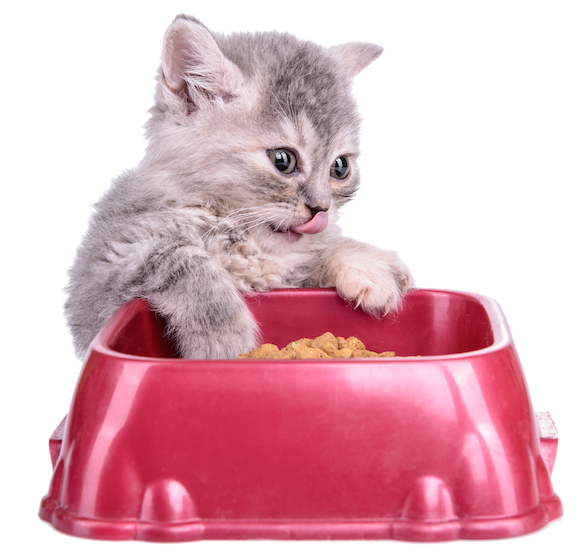
How much thought do you give feeding your cat?
This is more than of passing interest because both weight and the food fed have a big impact on feline health. For example, being overweight increases the chance of your cat becoming diabetic while foods high in certain minerals increase the risk of bladder problems. Big-boned or fluffed up, it’s important to be honest about your cat’s weight. Even a sleeping cat can give you clues because when lying down one tell-tale sign of “extra layers of love” is a hovercraft-like skirt around the tummy.
The Ideal Cat Food
The ideal food for cats is mice!
OK, this is true but not practical (or socially acceptable). The truth is cats eat mice–and the whole mouse at that–including fur, bones, and gut contents. The latter is the reason a meat only diet of chicken breasts is unhealthy and may result in the cat equivalent of osteoporosis, with brittle bones that are prone to fracture. A good diet is high in protein, so watch out for cheap foods that are high in plant based fillers that are unsuited to a cat’s digestive system. Ironically, some luxury cat foods are high in additives and minerals that make the food ultra-tasty, but can strain the kidneys.
Your best bet is a premium cat food from a manufacturer who makes prescription diets. These companies approach making pet food from the opposite direction–feeding sick animals and getting them better–and then diversified into providing ideal nutrition for healthy animals. These foods are science-based formulations and are lower in problematic minerals and additives.
Check Out the Chubby Factor
#1 Regular weigh-ins: Get your veterinarian’s opinion about your cat’s body size, along with a baseline weight. Then weigh your pet regularly at home, to check things are going in the right direction.
#2 Tape measure: Get things taped by measuring your cat’s girth once a month. This isn’t the most accurate method, but it does warn you when the pounds are piling on.
#3 Body scoring: This combines looking at your cat’s body shape with how easy or difficult it is to feel his ribs. From this, you rate the cat and monitor over the months.
How Much to Feed
If you’re confused about how much to feed, here are some tips for a healthy waistline.
#1 Start from scratch
The food packet should have a guideline on how much to feed each day. Use this as a starting point, but once a week assess your cat to see if they have lost or gained weight. Use this information to judge whether to increase or decrease the daily ration.
#2 Grazing or mealtimes?
Knowing whether to feed a cat at set times or let him graze, can be difficult. Cats are by nature “snackers” so ad lib feeding best fits their natural inclination. However, some cats are comfort eaters and will snack too often and become overweight. For these animals then controlling their calorie intake with set mealtimes is a better idea.
#3 Behavioral strategies
In the wild, hunting and eating are important priorities. When it’s all too easy to hunt down a bowl of biscuits, the payoff is a happy hunter that’s too wide around the girth. So make kitty work for their supper by hiding small amounts of food around the house, or using puzzle feeders. This way the cat has to expend energy before getting the reward, which is mentally stimulating and keeps her fit.
Dieting Your Cat
If there are a few too many inches of love around your cat’s tummy, then a diet is the order of the day. However, avoid crash diets.
Never Starve Your Cat
Starvation causes the feline metabolism to flood the liver with fat. Like a clogged drain, the fat stops the liver working properly, which sends it into organ failure.
Instead, avoid crash diets and simply cut back on his regular daily ration. If this doesn’t do the trick then consider a prescription weight loss diet from your veterinarian. These foods help the cat to feel full for longer, but without loading her up with calories.
And finally, don’t forget the power of play. Get your cat up on their paws chasing a wing on a string or a laser pointer. Not only does this do their body good, but also it’s mentally stimulating, which means less chance of kitty comfort eating.